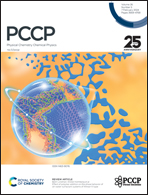Control of polymer–protein interactions by tuning the composition and length of polymer chains†
Abstract
Nanomoduling the 3D shape and chemical functionalities in a synthetic polymer may create recognition cavities for biomacromolecule binding, which serves as an attractive alternative to natural antibodies with much less cost. To obtain fundamental understanding and predict molecular design rules of the polymer antibody, we analyze the complex structure between the biomarker protein epithelial cell adhesion molecule (EpCAM) and a series of polymer ligands via molecular dynamics (MD) simulations. For monomeric ligands, strong enrichment of aromatic residues in protein binding sites is revealed, in line with the reported observations for natural antibodies. Yet, for linear polymers with a growing degree of polymerization, for the first time, a drastic change is revealed on the type of enriched protein residues and the location of protein binding sites, driven by the increasing steric hindrance effect that makes the adsorption of the polymer in the protein exterior feasible. Varying the polymer length and monomeric composition also significantly affects the ligand binding affinity. Here, we have captured three distinct dependences of the ligand binding free energy on the degree of polymerization: for NIPAm based hydrophilic polymers, TBAm dominated hydrophobic polymers and AAc dominated charged polymers. These results can be rationalized by the complex structure and the composition of protein residues at the binding interface. The entire analysis demonstrates unique binding features for polymer ligands and the possibility to modulate their binding sites and affinity by engineering the polymer structure.



 Please wait while we load your content...
Please wait while we load your content...